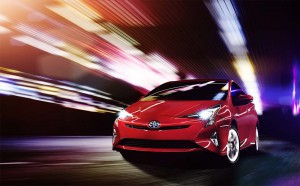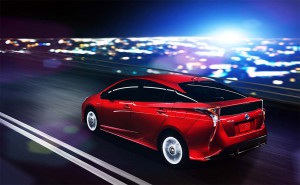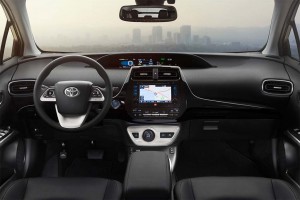It’s not only the world’s best-selling hybrid-electric vehicle but has routinely been one of the top sellers overall in green-minded markets like California and Japan. Now, Toyota is launching an all-new version for 2016, but cheap gas prices may be just one reason why the Toyota Prius could face its biggest challenge yet, industry experts warn.
The market has been flooded with hybrid competitors since the Toyota Prius was last redesigned in 2009, along with a variety of other high-mileage options. Meanwhile, sales of battery-based vehicles, in general, have been plunging this year. That helps explain why Toyota is downplaying fuel economy and putting more of an emphasis on the other attributes of the new Prius, including what it promises will be a more fun-to-drive road manner.
The new model “has a certain presence to it that will appeal to a broader range of buyers,” said Bill Fay, general manager of the Toyota brand in the U.S., following the unveiling of the fourth-generation Prius Tuesday night in Las Vegas.
The new hybrid is longer, wider, lower and a bit roomier. It has a new double-wishbone suspension and a lower center of gravity that should give it more sporty handling. It has a more lavishly equipped interior, adds more safety and infotainment technology, and adopts a new, more aggressive exterior design.
(Click Here for a closer look at the 2016 Toyota Prius.)
If anything, those attending the Tuesday night preview generally agreed that the 2016 Toyota Prius is less visually distinctive, more mainstream than the first three generations. It remains to be seen how consumers respond to that. Part of the appeal of the earlier models was the fact that the car immediately stood out as something special. But internal Toyota research also found that some potential buyers didn’t like the hybrid’s quirky shape.
“It should have broader appeal because it is more conventional looking,” said John O’Dell, a specialist in green car technology for data service Edmunds.com.
(Click Here to check out the hottest new car launches coming in 2016.)
Toyota is keeping many of the details about the new Prius secret prior to its launch early next year. It won’t discuss what changes it has made to the Hybrid Synergy Drive system, though it has been widely reported that the new 2016 model will get a larger, 1.8-liter gas engine paired with its twin electric motors.
While final mileage numbers have yet to be determined by the EPA, Toyota hasn’t ignored fuel economy, the maker anticipating the 2016 Prius will get about 10% better mileage than the outgoing hybrid – which would translate into something around 55 mpg in the combined city/highway cycle.
On the plus side, that would translate into the best mileage of any vehicle on the road but for a handful of plug-in hybrids and pure battery-electric vehicles.
But with energy sector analysts predicting gas prices could dip to $2 a gallon by year-end, the question is whether that matters as much as it did during the peak years of the third-generation Prius, when gas cost twice as much and the trendline seemed to be heading towards $5 or higher.
“That’s a real challenge,” said Stephanie Brinley, a senior auto analyst with IHS Automotive. The cheaper gasoline becomes “the harder it is to justify a hybrid like Prius financially.”
There are now a number of similarly sized gasoline-powered vehicles getting as much as 40 mpg, Brinley noted. For a motorist clocking a typical 12,000 miles a year, the new 2016 Toyota Prius would use less than 220 gallons of gas compared to 300 gallons for the all-gas model. At current fuel prices, the savings would come to barely $200 a year. That would make it hard to recover the higher cost of a hybrid like the new Prius compared to the conventionally powered model.
What is obvious is that Toyota “wants it to be more than just a payback car,” said Brinley. “They want to make it desirable for more than just fuel efficiency.”
But how potential buyers will react remains to be seen. For Toyota, the good news is that Prius has a loyalty – or repurchase – rate among the highest in the maker’s entire portfolio, and Fay said he is confident, “our current owners will want to trade up.”
Still, recent trends are worrisome. Demand for the familiar Prius hatchback was off 16.3% for the first eight months of 2015 compared to year-earlier numbers. Some of that may be the result of potential buyers waiting for the new model, but sales of all battery-based vehicles are off by double-digits. Significantly, two of Toyota’s hottest models right now are the big Highlander SUV and Tacoma pickup, both having their strongest years since 2003.
Toyota will have to find the right formula for marketing the 2016 Prius, industry analysts caution. It will have to continue pushing the hybrid’s green benefits to traditional, environmentally motivated buyers while playing up the car’s new styling, handling and refinement for everyone else.
(Click Here for a review of the new 2016 Toyota Tacoma.)




Government incentives for these type of cars will keep this car going strong.
7k and counting taxpayer incentives
Please don’t compare the “40 MPG highway” to the “50 MPG combined” of the Prius. Compare the ‘combined’ numbers for equivalent sized cars.
For example, we found only one, the 2015 Mitsubishi Mirage, 1.2L, that gets 40 MPG at 103 ft{3} vs 2015 Prius, 1.8L, at 116 ft{3}. So the Mirage is 80% of the mileage and 88% of the space. With the new Prius, it will be 73% of the mileage.
Prius owners use a different metric, the product of the volume times miles per gallon. This efficiency number determines whether a vehicle is a good buy, an efficient carrier of our lives down the highway. Then the only question is how much can we afford.
You might also mention the Toyota auto-braking, lane following, and adaptive cruise control is going to all models. This is very big for us senior drivers.
Bob Wilson, Huntsville, AL
Considering VW/Audi clean diesels will easily get high 40 to low 50 mpg real world results which exceed the EPA test data results, hybrids are still a tough sell.
Comparing mpg based on interior volume and advertised EPA mileage doesn’t produce accurate info. as the mpg varies by vehicle weight, speeds driven, road and weather conditions and many other factors. All of these factors impact actual results.